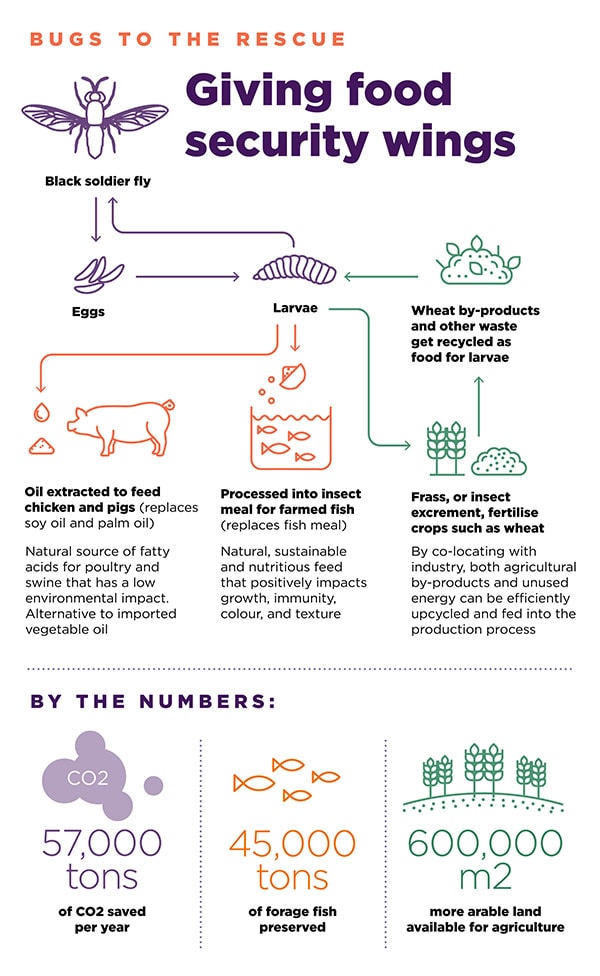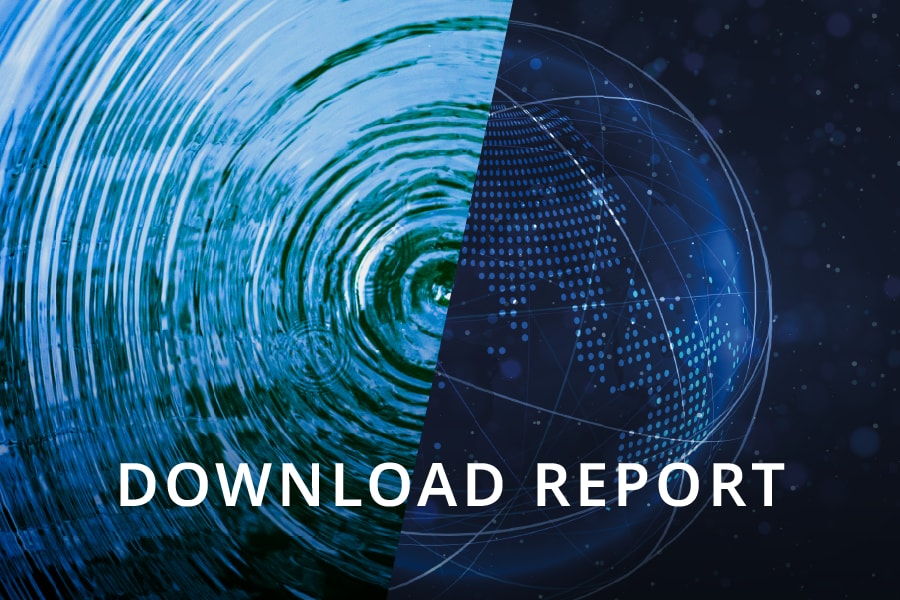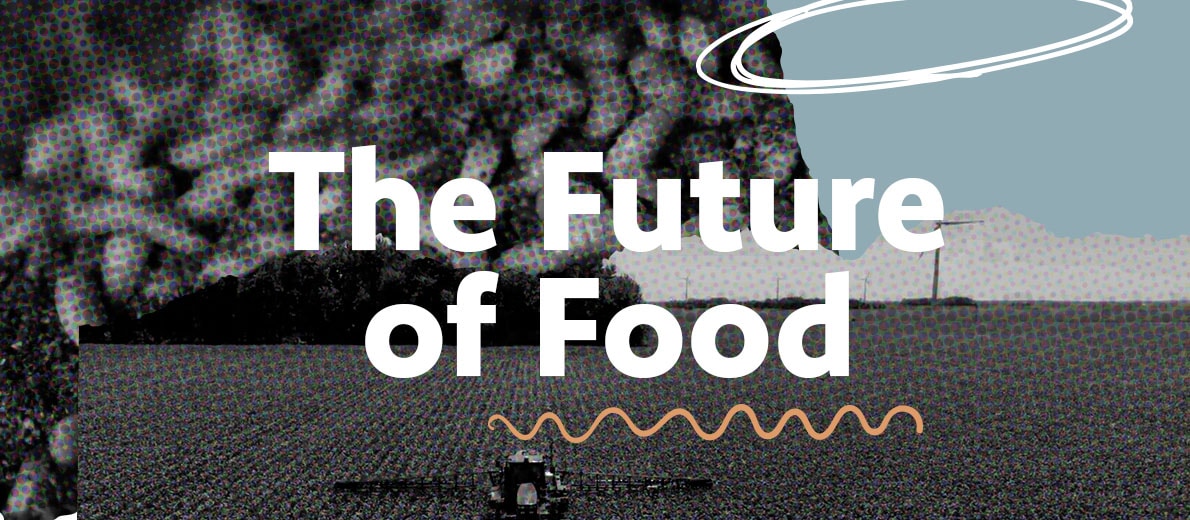Burning Questions: The Future of Food
Burning Questions: The Future of Food
In brief:
- By 2031, global meat and fish consumption will increase a further 15%, putting a strain on production resources
- Insect farming produces a highly nutritious and environmentally-friendly alternative to conventional animal feed
- New technologies can help scale the production of insects to make this a viable option
Insects are a traditional source of food for many animal species. With new technologies allowing them to be bred at scale, they represent a viable – and sustainable – protein source for agriculture and aquaculture.
As the world’s appetite for animal protein grows, there is increasing strain on the resources needed to produce enough feed to sustain our livestock. Already, around 80% of agricultural land is used to produce animal feed. Meanwhile, millions of tonnes of fish are fed to farmed fish amidst rising concerns of overfishing.
In the search for a more sustainable solution, insects could hold the key.
Sebastien Pascual from Temasek’s Agri-Food team and Aude Guo from insect protein biotech startup Innovafeed answer your Burning Questions about insect proteins and the critical role they can play in aquaculture and agriculture, and explain the urgent need for more innovative approaches to food production.
Insect protein can help make aquaculture more sustainable by reducing overfishing and improving the quality of fish that we consume. Transformative technology makes this possible.
Sebastien Pascual, Director, Investment (Agr-Food), Temasek
Why are we turning to insects as a feed option?
Sebastien: Fish is the fastest-growing form of animal protein, and high demand has led to overfishing for the vast majority of species that we eat. While aquaculture is a solution, key species such as salmon and shrimp are carnivorous, so they are fed fish meal, which contributes to overfishing. Insect feed is a way to mitigate that.
Aude: Insect feed is also highly nutritious and easily digested. Compared to conventional feed, it requires fewer resources to grow and has a lower carbon footprint.
Should farmed animals even be eating insects? Is it safe?
Aude: It is safe. When you go fishing, you use insects as bait because that is what fish consume. In nature, poultry and pigs eat insects every day. Insect feed simply takes them back to a more natural diet, and when animals consume a more natural diet, they are healthier. We have seen an increase of over 25% in the survival rate of shrimp that are reared on insect feed compared to conventional feed. For farmers, it means higher yields.
How will it affect the taste of my chicken and fish?
Aude: Better nourished and healthier animals make for tastier end-products for consumers. We have seen this in fish reared with insect feed. Researchers in Germany also recently found that chickens fed with black soldier fly larvae meal fared as well as those fed with soybean meal in laboratory testing and taste tests.
How are insects reared as feed?
Aude: Insect farming requires very little land, water and energy, while waste can be recycled as food for the larvae.

How does traditional farming hurt the environment?
Sebastien: Agriculture is responsible for about 20% to 30% of global carbon emissions. There is a sizable contribution to climate change coming from how we produce what we eat.
Aude: To reach the targets set by the United Nations to limit global temperature rises to 1.5-2.0 degrees Celsius, we need to reduce carbon emissions by 45% from 2010 levels by 2030. This can only be done by changing the way we produce and consume food. We conducted a life-cycle analysis that showed that the carbon footprint for insect feed production was at least 50% smaller compared to that of existing protein sources, on top of offering an alternative nutrient source of higher quality.
Are we running out of food?
Sebastien: For now, there is enough for everyone. However, we rely on a global supply chain that could be impacted by events such as Covid and geopolitical crises. With an additional 2 billion people to feed by 2050 and the bulk of population growth in Asia and Africa, our food supply will be placed under greater stress if we don’t act now. We can make a choice today to help avoid a food crisis in the future by making the supply chain more sustainable.
Aude: Insects also reduce the need to grow more crops, rear more livestock or catch more fish for conventional feed. This helps alleviate carbon emissions, safeguarding our natural environment while securing long term food supply.
How can technology help us feed more people in a sustainable way?
Sebastien: With technological advances, farmers today can produce more food more affordably and with improved nutritional value than at any point in our history. Emerging technologies could allow us to feed even more people with less environmental impact.
Aude: We share Temasek’s belief that disruptive technology can bring positive change. At Innovafeed, we use robotics, data analytics, and artificial intelligence for real-time monitoring and to optimise the environment in which the insects grow so their growth and quality are maximised while their energy, water and land consumption are minimised. To reduce our carbon footprint further, we recycle agro-industrial by-products and waste streams to feed our insects, and energy waste streams, such as heat, for our own processes. So with cutting-edge technology, we have been able to get a very good product at the lowest carbon footprint possible. At a production facility the size of our factory in Nesle, France, this would represent CO2 emission reductions of 60,000 tonnes a year, equivalent to the emissions generated by a city of 6,000 people.
At Temasek, sustainability is at the core of all that we do. We actively work with our portfolio companies to address the climate challenge, reverse the loss of nature and build a more inclusive society.
Temasek is an investor in Innovafeed.


